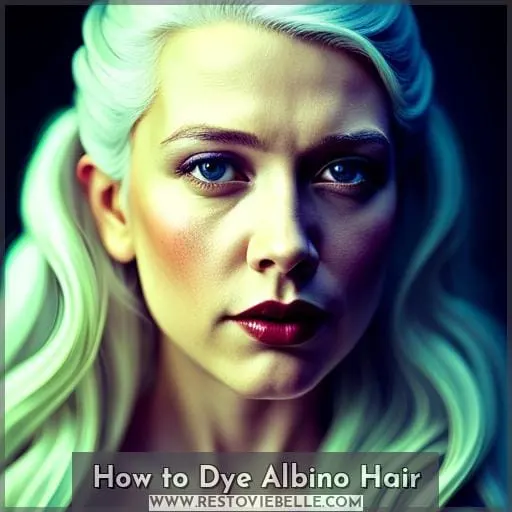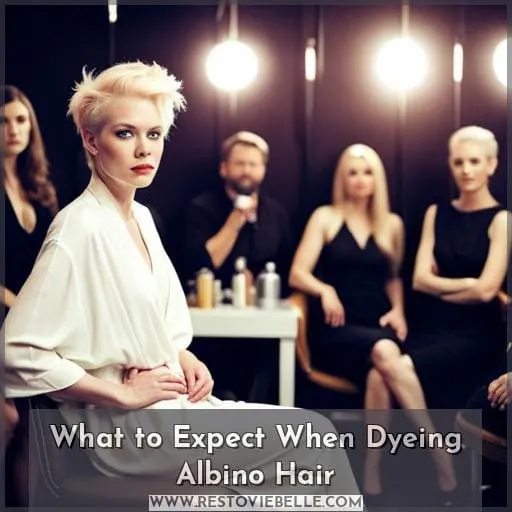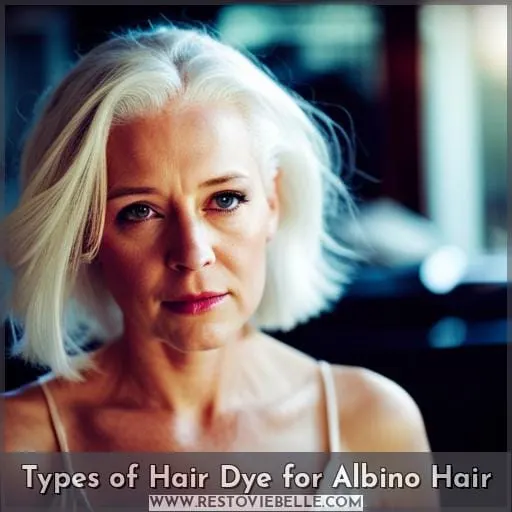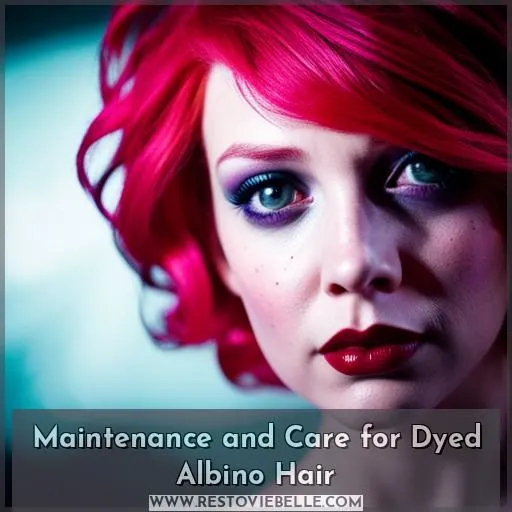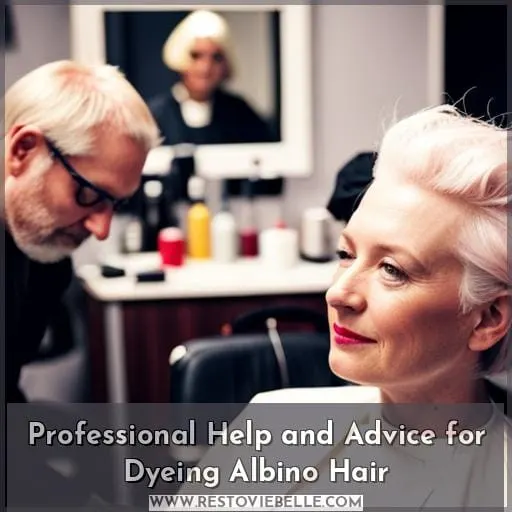This site is supported by our readers. We may earn a commission, at no cost to you, if you purchase through links.
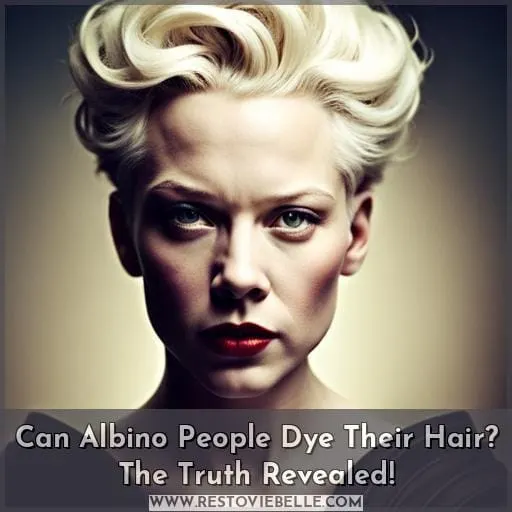 Did you know that over 1 in 20,000 people have albinism? It’s a genetic disorder that affects the production of melanin pigment and results in little to no color in hair, skin, and eyes.
Did you know that over 1 in 20,000 people have albinism? It’s a genetic disorder that affects the production of melanin pigment and results in little to no color in hair, skin, and eyes.
As an albino person looking for ways to express yourself with color, it can be hard to find answers on whether or not you are able to dye your hair. Fortunately, the answer is yes! You can absolutely dye your hair as an albino individual.
However, there are some important things you need to consider before beginning this process.
In this article, we will explore what needs to be taken into account when dyeing your already pale locks, how to best approach the process itself, and which types of dyes work best for achieving maximum vibrancy without damaging delicate strands or causing scalp sensitivity due to low melanin levels found in those living with albinism.
Let’s get started!
Table Of Contents
Key Takeaways
- Albino individuals can dye their hair using semi-permanent or ammonia-free dyes.
- Adhesion and longevity of dye can be challenging on albino hair.
- Hair dye try-on apps help in selecting the desired color.
- Maintenance and care are essential for vibrant and healthy colored hair.
Can Albino People Dye Their Hair?
It’s possible for individuals with albinism to dye their hair and express themselves through their hair color. They have the option of going to a salon or doing it themselves. Before starting the process, they should use try-on apps to choose the desired shade and gather all the necessary supplies, such as clarifying shampoo, gloves, and dye.
To prevent staining of the skin or clothing, it’s recommended to apply Vaseline around the perimeter of the head before dyeing each section thoroughly, one at a time. The dye should be left on for 45 minutes or longer if needed. It’s important to note that stark white hair may have adhesion issues and may not last as long as non-albino colors.
For individuals with albinism, it’s recommended to use semi-permanent ammonia-free formulas due to increased scalp sensitivity when using chemical dyes. Henna is also a natural alternative option for those who prefer it. Taking safety measures beforehand will help achieve vibrant results without causing any damage.
In conclusion, individuals with albinism can dye their hair and express themselves through different hair colors. By following the recommended steps and using the right products, they can achieve beautiful results and feel confident in their appearance.
How to Dye Albino Hair
Before you can successfully dye your albino hair, it is important to take several steps in preparing for the process. To ensure the best results and minimal damage, try using a hair color try-on app to pick out your desired shade of dye, gather all needed supplies such as clarifying shampoo, gloves, and protective clothing/workspace before starting.
Then follow this step-by-step guide for an even application of semi-permanent or ammonia-free dyes that will help create vibrant locks without skin issues.
Preparing for the Dyeing Process
Before you take the plunge into a new hair color, make sure to consider these key steps for proper preparation:
- Choose the desired shade with help from try-on apps.
- Gather supplies like clarifying shampoo, dye, and gloves.
- Protect clothing and scalp by applying Vaseline around the head’s perimeter. Allergy testing is essential to prevent skin issues—opt for temporary or semi-permanent dyes instead of harsh chemical formulas! Styling tips include using low pH shampoos and natural oils on albino hair after every 2-3 weeks’ deep conditioning session for optimal results without damage or fading quickly.
Step-by-Step Dyeing Process
Divide your tresses like a map, clipping each section into place so you can apply the dye as precisely as possible.
Start by selecting an appropriate albino hair dye to suit your desired color shade.
Use Vaseline around the head’s perimeter to avoid staining while applying the product in small sections from root to tip for even coverage and saturation.
Leave it on for 45 minutes or more with heat if needed before rinsing off with cold water and conditioning afterwards.
Multiple sessions may be necessary due to the lack of melanin pigment in white hair, but vibrant results are achievable when done correctly!
What to Expect When Dyeing Albino Hair
It is possible for albino individuals to dye their hair, but there are certain considerations and precautions that must be taken. Adhesion of the dye on white hair may not always be successful due to its lack of melanin, and the longevity of color may also prove difficult compared to non-albinos.
There is potential for damage, including scalp irritation or dryness, as well as irreparable harm to the follicles if not done correctly. It’s important, therefore, that individuals consider dyeing their eyebrows too in order to match with dyed locks.
Adhesion and Longevity of Dye
When dyeing albino hair, it’s important to consider the adhesion and longevity of the color. Techniques such as applying Vaseline around the perimeter of the head or using low pH shampoo can help with pigment challenges.
Allergic reactions are also possible, so testing dyes before use is essential for scalp health. Semi-permanent dyes may be more suitable than permanent colors due to potential fade issues, but they must have good adhesion for the best results! Additionally, applying natural oils like jojoba oil in combination with synthetic conditioners will protect both the hair and scalp from damage caused by chemical dyes over time.
Dyeing Eyebrows
Consider dyeing your eyebrows to match your hair color, like Samantha did when she dyed her brows auburn to match her newly-dyed red hair.
Beforehand, it’s important to select an appropriate shade for pigment-free brows and thoroughly test dyes for allergies.
When you’re ready, carefully apply Vaseline around the perimeter of your head. Then, divide your eyebrows into sections using clips and apply the dye section by section.
For individuals with unique needs, such as albinos, there are specific techniques to consider. You can use semi-permanent or temporary formulas that last longer on white or platinum locks. Additionally, there are chemical-free henna options available if you’re concerned about scalp damage or health issues.
After rinsing the dye with cold water, make sure to condition your eyebrows. To maintain the results for a longer period, follow a maintenance routine that includes using a low pH shampoo and incorporating natural oils like jojoba oil into your conditioner.
By following these steps, you can achieve optimal results and enjoy your newly-dyed eyebrows for an extended period of time.
Potential Hair and Scalp Damage
Take caution when dyeing albino hair, as chemical dyes may cause potential damage to both the scalp and strands. Opt for ammonia-free formulas or henna to color safely without risking irritation or hair loss.
Regular conditioning with natural oils is essential for keeping colored strands healthy and vibrant.
When using synthetic products, seek out ones specifically formulated for dyed hair. They’ll help protect against dryness and breakage caused by coloring agents. Minimize heat styling tools too. Instead, opt for air drying methods where possible to prevent further damage from excessive heat exposure.
Types of Hair Dye for Albino Hair
Dyeing albino hair is a challenging yet rewarding experience. Semi-permanent and ammonia-free formulas are recommended for achieving vibrant results, while henna provides an all-natural, chemical-free alternative suitable for those concerned about scalp and hair health.
Recommended Dye Formulas
For optimal results, opt for semi-permanent or temporary dyes that’ll give you vibrant color without skin irritation. Ammonia-free options are highly recommended as they’re gentler on the scalp and provide a natural look.
Natural dyes like henna can be used to avoid allergic reactions caused by chemical hair colors and also add nourishment to the hair strands.
To protect your scalp from damage, consider consulting a professional colorist before dyeing your albino hair. They can provide reliable advice on suitable products specifically designed for albinos, such as ammonia-free formulas or non-toxic natural dyes.
These options will help you achieve the desired results with minimal risk of harm.
Additionally, coloring your eyebrows is also an option if you want them to match your newly dyed locks!
Henna as an Alternative Option
Henna is a great option for those wanting to add color to their locks without using harsh chemicals. The benefits of henna include natural results, no need to worry about allergic concerns, and a wide array of colors that can be achieved.
When applying henna on albino hair, it’s important to consider the type – oculocutaneous or ocular – as well as the desired level of intensity. Temporary or permanent dyeing sessions may be necessary. To protect scalp health and ensure even coverage throughout the strands, follow application tips found online or consult a professional colorist before beginning the process.
Maintenance and Care for Dyed Albino Hair
Dyeing your hair can be a great way to express yourself, especially if you are an albino individual. To ensure the longevity and vibrancy of dyed albino hair, it is important to maintain a consistent color maintenance regimen and utilize hair care products that are specifically designed for colored hair.
Color Maintenance Regimen
To ensure vibrant, long-lasting results, create a color maintenance regimen with a low pH shampoo and natural oils like jojoba. Deep conditioning every 2-3 weeks helps retain moisture in the scalp while preventing color fade.
Natural oils protect albino hair from damage caused by harsh chemicals in dyes or styling products. A haircare routine tailored to dyed albino hair should also include leave-in conditioners that have moisturizing ingredients such as shea butter or olive oil for added nourishment and shine.
Regular trimming is necessary to avoid split ends, which can lead to further breakage of already fragile strands due to the lack of melanin pigment production on the scalp.
Haircare Products for Dyed Hair
Opting for products tailored to dyed hair is key to keeping dyed locks healthy and vibrant. Choose a low pH shampoo designed for colored hair, leave-in conditioners with natural oils like jojoba oil, and avoid using heat styling tools.
For a thorough color maintenance routine, deep conditioning every 2-3 weeks helps maintain dye longevity while protecting the scalp.
Professional Help and Advice for Dyeing Albino Hair
Getting professional advice before dyeing your hair is an important step for albinos to ensure both safety and the desired result. Consulting a colorist can help you pick out the right shade of hair dye that won’t cause any damage to your scalp or skin, especially if you have sensitive skin due to albinism.
Allergy testing should also be done beforehand, as well as assessing whether there will be issues with adhesion on stark white hair. Hair health should always be taken into consideration when selecting products; opting for semi-permanent or temporary dyes over ammonia-based ones may provide more vibrant results without risking scalp protection.
Professional guidance can make all the difference in achieving beautiful results while maintaining healthy locks!
Conclusion
As the saying goes, there’s more than one way to skin a cat, and this couldn’t be more true when it comes to dyeing albino hair. It is possible for albino individuals to dye their hair; however, it is important to ensure safety precautions are taken and proper advice is sought to achieve the desired result.
Professional help, product selection, and maintenance and care are all crucial steps to ensure the hair remains healthy and vibrant. By following these tips, albino individuals can confidently dye their hair and express themselves without fear of damaging their hair or scalp.
